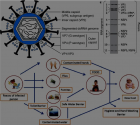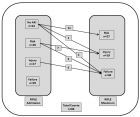About Instituto do Cancer dr Arnaldo Vieira de Carvalho
Instituto do Cancer dr Arnaldo Vieira de Carvalho
Articles by Instituto do Cancer dr Arnaldo Vieira de Carvalho
Electrocoagulation with greased lidocaine gel 2% as hemostatic maneuver after minimally invasive partial nephrectomy: Experimental and preliminary clinical results
Published on: 29th April, 2020
OCLC Number/Unique Identifier: 8861740671
Methods: Experimental phase: Performed a partial nephrectomy off clamp in pig model followed by cauterization of lidocaine gel 2% with different power (control, 30W, 50W and 100W) in the kidney resection bed to evaluate efficacy and deep injury extension.
Clinical phase: 20 patients submitted to laparoscopic or partial nephrectomy for low risk RENAL score were utilized greased lidocaine gel 2% with 50W in cautery scalpel to hemostasis of renal parenchima to validate efficacy and safety.
Results: Experimental study shows that this technique is effective and promote better hemostasis with 50W and 100W, with deep injury of less than 3 mm.
Clinical study confirm efficacy, good control of hemorrage, few complications and no transfusion. Minimal changes in hematocrit, haemoglobin and creatinine were observed.
Conclusion: In this preliminary experience the use of this new alternative to hemostasis for low risk partial nephrectomy was satisfactory and with good intra and postoperative results.
The best advantages were safety in terms of the depth thermal injury, low cost and absence of artifacts over the resection area observed at CT scan postoperatively.
“Maximum Preservation Radical Prostatectomy”: Oncological, functional and other contemporary aspects of Retzius Sparing Robotic Assisted Radical Prostatectomy
Published on: 30th April, 2020
OCLC Number/Unique Identifier: 8861737601
The surgical treatment of prostate cancer (PCa) had as its initial milestone the first prostatectomy, performed by H.H. Young at the Johns Hopkins Hospital, in 1904 [1], however, the procedure only reached a fundamental role after 1982, based on a better understanding and description of the male pelvic anatomy, by Walsh [2-6] and other [7-11]. Subsequently, minimally invasive approaches emerged: laparoscopic prostatectomy (1992) [12] and robot- assisted laparoscopic prostatectomy (RALP) (2000) [13], which modified and optimized the execution of key surgical steps of this procedure, such as bladder neck preservation, nerve-sparing dissection, and prostate apex management [14].
3D software reconstruction for planning robotic assisted radical nephrectomy with level III caval thrombus
Published on: 30th April, 2020
OCLC Number/Unique Identifier: 8861737634
Inferior vena cava (IVC) involvement by intraluminal extension of tumor is infrequent, occuring in 4% to 10% of patients with renal cell carcinoma (RCC) [1-5]. Based on the cephalic extension of the thrombus, Mayo [6] described a classification of inferior vena cava thrombi in 4 categories, which has implications on surgical complexity, estimated blood loss (EBL) and peri-operative complications, but not cancer-specific survival [2,7]. Level III IVC thrombus is classified as being located in the retro-hepatic IVC below the diaphragm. Total resection of this tumor is the best chance of cure when no distant metastases are present [4,8]. Actually, open radical nephrectomy with concomitant thrombectomy is still the standard treatment. This procedure is technically challenging and involves a large incision and prolonged convalescence [9]. Recently, the feasibility of robotic IVC thrombectomy has been demonstrated, with potential lower EBL and shorter hospitalization and convalescence [7,10-14]. This surgery requires thorough knowledge of surgical anatomy, detailed pre-operative preparation and meticulous robotic technique [7]. The key point in the surgical management is the correct assessment of the extension of the endocaval thrombus, what is mainly based on radiological examinations [8]. Although Ultrasonography (US) and computerized tomography (CT) are useful in demonstrating the extent of the thrombus, CT is not always accurate in delineating the superior margin of the tumor in the IVC. More precisely, magnetic resonance imaging (MRI) can demonstrate a tumor thrombus and its extension, besides signs of wall invasion, being extremely useful to surgical procedure planning [8,15]. Vena cavography is not additive to US, CT, and MRI, and it increases the risk of contrast-associated renal injury [4,8]. However, new modern image technologies has emerged to help surgical planning, as three-dimensional visualization technique (3DVT) based on routine CT or MRI processed image data [16-20]. Recently, a comparative study showed advantage of 3DVT in management of complex renal tumor during laparoscopic partial nephrectomy [20]. This modality is able to demonstrate anatomy relations, allowing the surgeon to observe the relationship between targeted tumor and peripheral structure before surgery and perform virtual manipulation. This kind of preoperative accurate assessment can enhance surgeons confidence of surgical procedure and decrease surgical risk and incidence of complications [20]. There is no report in the literature of the use of this type of technology in cases of IVC tumor thrombus.
We present the use of 3D holographic interactive reconstruction in a single case of robotic radical nephrectomy with level III IVC thrombectomy.

If you are already a member of our network and need to keep track of any developments regarding a question you have already submitted, click "take me to my Query."


















































































































































